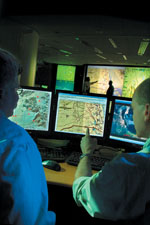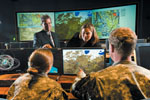Enabling the Revolutionary Leap
 |
During a typical experiment, the Boeing Company’s Analysis, Modeling, Simulation and Experimentation (AMSE) team hosts clients in one of their many facilities worldwide to participate and offer feedback. |
Modeling and simulation is bringing the world into the command center, into the boardroom and even onto the desktop. The value of models and simulations is increasing significantly as organizations use bits and bytes to strategize. Traditionally, the capabilities have been used for testing and training. But now, by getting to know their customers’ aspirations intimately, companies are employing these techniques to give their clients what they need, while strengthening their own bottom line.
One of the largest firms to take this tack is the Boeing Company,
According to Capt. Guy Higgins, USN (Ret.), Boeing is in the midst of a transformation of sorts in the area of modeling and simulation. As the vice president of the company’s Analysis, Modeling, Simulation and Experimentation (AMSE) business sector, Phantom Works,
Capt. Higgins can truly assess the benefits that his team brings to both the military and Boeing because during his professional life he has worn both hats: consumer and creator. In addition to being an aerospace engineer, he collected more than 4,000 flight hours as a naval aviator; he is a graduate of the U.S. Naval Test Pilot School and was a consumer of modeling and simulation capabilities nearly 20 years ago. On the acquisition side, Capt. Higgins was a major program manager twice while in the Navy, for a total of more than six years. He has been working for Boeing for 10 years.
Several years ago, during one of its annual events, the Boeing Integrated Defense Systems (IDS) staff took a step back to examine how it was conducting its own business, Capt. Higgins explains. “The observation was made that there were a number of places where we had not done a remarkably good job. One of them was that no one had taken the initiative to integrate the modeling and simulation capabilities across all of the legacy companies of Boeing,” the captain shares. As with many large defense contractors, Boeing had acquired entire companies or portions of companies over the years, including McDonnell Douglas, Hughes and Rockwell. However, although it was probably spending more than $500 million in modeling and simulation throughout its facilities, coordination was absent.
As a result of those discussions, Boeing’s leaders established an organization with positional, organizational and budget authority to pull the capabilities together. Capt. Higgins was tasked with owning some of these capabilities and influencing others.
Today, the facilities that are in some way involved in modeling and simulation span the globe. Primary locations include
This revamping of the company’s modeling and simulation assets took place with two goals in mind: to better meet the customers’ needs by offering a full force of experts and to contribute to Boeing’s strategic plans for the future of the company, Capt. Higgins explains. “When we stood the organization up, we decided we would need to understand—from a position of Boeing Integrated Defense Systems—where Jim Albaugh [executive vice president at Boeing, and president and chief executive officer of the IDS group] and the business share presidents were going. I have to intimately understand those strategies in order to anticipate their needs one to three years in the future, then create the capabilities so that it is a just-in-time capability for them,” the captain notes.
For example, if the company needs modeling and simulation capabilities for an experiment in
Once the AMSE team understood the IDS’ strategies and goals, it established its own strategic objectives. Now, it examines its customers’ foundational documents, such as the U.S. Defense Department’s National Defense Strategy, and determines the capabilities that it needs to develop to help accomplish those goals.
It is at this point that AMSE staff begins to let its imaginations take over. Discussions include ideas about simulating a capability without regard for whether it can actually be developed and created. “We say, “Suppose that I had the capability to maintain a continuous surveillance of a certain size geographic area,’” Capt. Higgins submits. “We can take and put that into a simulation, then, working with our internal customers [Boeing business sectors], we invite our external customers—say the Air Force or the Army—to provide us with real warfighter operators who come in, sit down with us and run an experiment.”
A four- to five-hour simulation such as this runs in a live-virtual-constructive environment. It begins with a hypothesis, such as “a continuous surveillance capability would reduce the amount of insurgent violence by 75 percent,” the captain explains. Data is collected during the experiment, and then an extensive after-action review takes place. The AMSE team asks operator participants for their opinions about a capability and input about what led them to make certain decisions during the simulation. The simulation then is repeated with a slightly different set of initial conditions, and data is collected again.
“What’s remarkable about this approach is that we and the customer learn from it together. Quite honestly, sometimes we learn things that are not terribly valuable. They are very valuable to the customer, but they are not terribly valuable to us because it points in a direction in which we have no ability to participate. And it may turn out that we and the customer find a solution that doesn’t involve materiel, so there is no system solution there. That’s not a bad thing for us; that’s a learning experience. And of course we build additional knowledge about how the customer operates,” the captain allows.
The captain quips that modeling and simulation provides the GFE, which stands for government-furnished equipment in the acquisition world but for God-furnished environment in the modeling and simulation world. He explains that in the real world, God provides environmental features such as air, dirt and gravity. In the simulated world, however, engineers must not only create these elements but also ensure that they are accurate so that radios, for example, will behave in a simulation the same way they will on the battlefield.
One example of how the AMSE is helping meet the modeling and simulation needs of clients originated with a question from one of the team’s members who asked what the company was doing in terms of network models and simulations. In response, the AMSE began a number of initiatives using either the customers’ network models or those created by companies that specialize in building network models.
The captain’s group recently collaborated with Boeing’s Command, Control, Communications and Networks division to create a network development laboratory that enables the AMSE to insert actual hardware into the networks that feature purely constructive communications nodes. For example, the team can bring the Joint Tactical Radio System prototype into the laboratory, connect it to other radios on a platform and connect as many or as few additional computer-simulated nodes as requested.
 |
AMSE staff members work closely with warfighters during simulations to examine solutions to problems such as theater of operations internal logistics and network communications in areas where infrastructure is nonexistent. |
The work that the AMSE is conducting extends beyond communications to logistics networks. For example, it is looking at the Defense Department’s short-haul mobility requirements. The focus is not on moving equipment halfway around the world but rather on finding the safest and most efficient way to transport it once it is within a theater of operations. Options include trucks, helicopters and fixed-wing aircraft, and the AMSE’s goal is to give military leaders the information they need to make better decisions.
“We’re putting together the models that allow us to look at the intra-theater lift issue in a system-of-systems situation, which we have found to be a very, very difficult challenge. It is difficult in terms of understanding the system-of-systems construct so that you can model it properly,” Capt. Higgins allows.
The captain emphasizes that the AMSE’s work is not only about solving today’s problems, but more importantly it is about exploring how new capabilities could affect decision making. “I’m making this up, but what would happen if we had the ability to continually monitor all of the nuclear industry in
“When I was on active duty, I said numerous times that it’s really important to have that kind of engagement, because if we left it up to the people who are fighting the war today, what they want is just what they’ve got, but a little bit better, more reliable and easier to use. So, you never get the photon torpedoes, the phasers and warp drive if you just continually make the existing things better. There has to be that interaction that allows people to make the revolutionary leap,” the captain says.
The team also must determine how new and legacy systems will interoperate while understanding the limitations of a simulation “because all simulations have limitations. It’s a wonderfully challenging and exciting environment,” he adds.
“My vision is that I would like you to be able to call me up this morning and say ‘I want to be able to do X, Y and Z,’ and we would be able to hook all the parts together globally to do it this afternoon. We’re not there yet. It takes days of preparation to be able to pull things together. And, if we’re really doing something new and innovative, it may take us a couple of months to put the new innovative things in there so that we’re sure that we will be able to learn from the simulation,” the captain shares. He predicts that “a very significant plug-and-play capability” will be available within five years.
WEB RESOURCES
Phantom Works: www.boeing.com/ids/phantom_works/index.html
U.S. Defense Department Modeling and Simulation Coordination Office: www.msco.mil




Comments